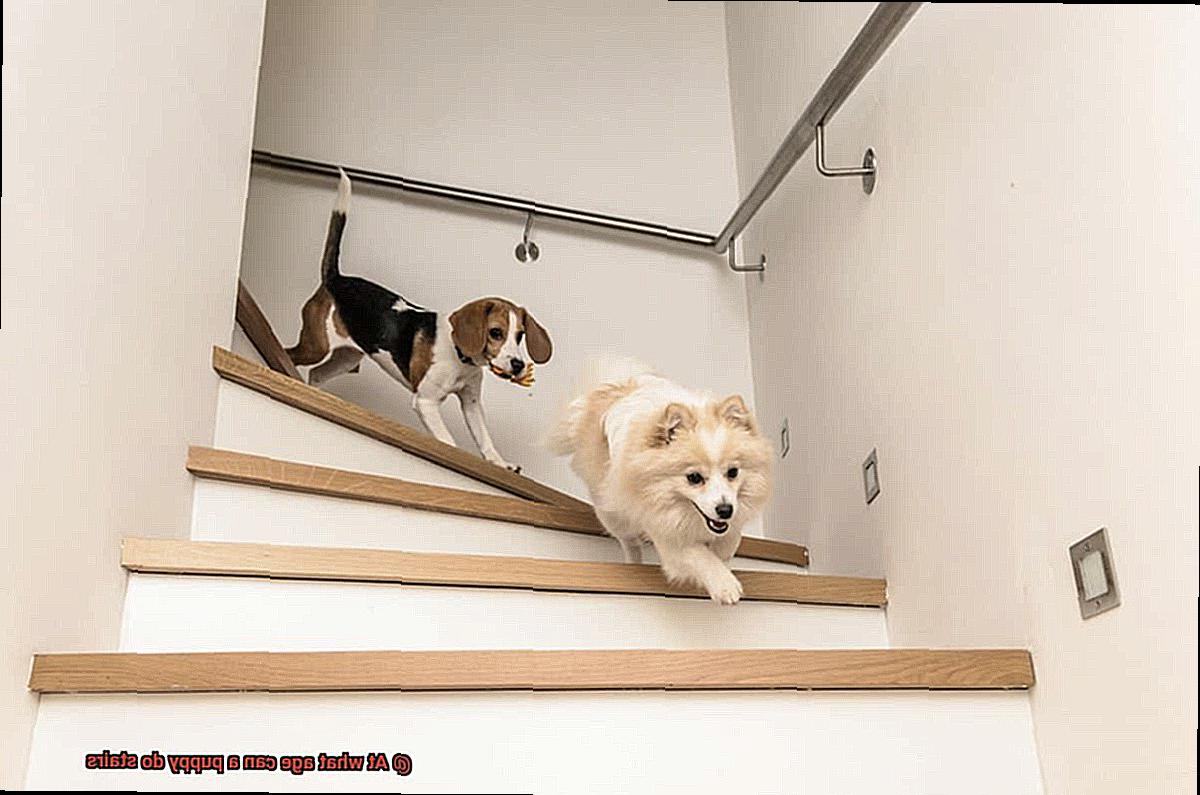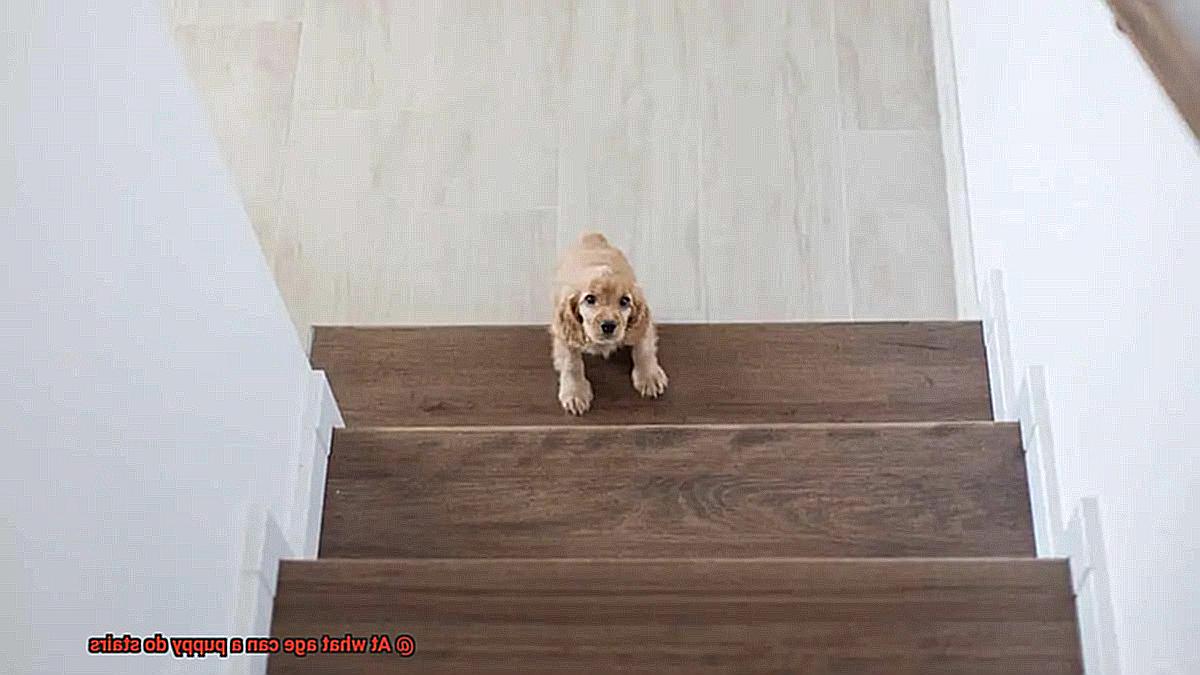At what age can a puppy do stairs?
Picture this: your adorable, pint-sized puppy, eyes filled with curiosity and determination, ready to take on the world – or in this case, the stairs. But before you let your furry friend embark on this vertical adventure, it’s vital to consider their physical and mental readiness. In this blog post, we’ll dive into the age at which puppies can safely conquer stairs, exploring both the potential risks and the reasons for introducing this skill gradually to our beloved four-legged companions.
Research suggests that puppies should be at least three to four months old before they venture up and down stairs independently. However, keep in mind that individual development and breed characteristics play a role in determining when your pup is truly ready. Why the wait? Well, those tiny bones, muscles, and joints need time to grow and strengthen before they can handle the strain of stair climbing. This is especially important for larger breeds prone to skeletal issues like hip dysplasia.
But it’s not just about physical prowess; mental development matters too. Early experiences significantly shape a puppy’s behavior and confidence. With proper training and positive reinforcement, our little explorers can gradually build confidence in tackling stairs. Patience is key here – avoid forcing a puppy up or down stairs prematurely as a traumatic experience could instill fear that lingers long after their bones are strong enough.
Now let’s talk safety risks because prevention is better than a trip to the vet. Allowing puppies on stairs too soon can lead to falls, joint injuries, or even stair-related phobias. To protect your pup while they develop their stair-climbing skills, consider installing temporary barriers such as baby gates until they are physically and mentally prepared for this new challenge.
In conclusion, while it may be tempting to witness our puppies conquering new frontiers like staircases, their safety and well-being should always come first. By considering both their physical and mental development, we can gradually introduce stairs as a positive and enjoyable experience for our furry companions. Remember, a little patience goes a long way in nurturing a happy, confident, and well-adjusted puppy.
Stay tuned for the next part where we’ll share some simple steps to train your puppy to conquer stairs with grace and confidence.
Understanding the Basics of Puppy Stair Training
Contents
- 1 Understanding the Basics of Puppy Stair Training
- 2 Factors That Influence a Puppy’s Ability to Navigate Stairs
- 3 When to Begin Introducing Your Puppy to Stairs
- 4 Tips for Teaching Your Puppy How to Use Stairs
- 5 Safety Considerations When Training Your Puppy on Stairs
- 6 How Smaller Breeds Like French Bulldogs Handle Stair Training
- 7 Supervising Your Puppy During Stair Training
- 8 Signs of Physical Discomfort or Reluctance From Your Puppy
- 9 Conclusion
In this article, we will provide you with all the information you need to ensure a safe and successful stair training experience for your furry friend.
When to Start:
Puppies develop at different rates, so it’s important to consider your French Bulldog’s breed and size. Due to their shorter legs and compact bodies, French Bulldogs may take longer to develop the coordination and strength needed for stair climbing. Generally, most puppies can start attempting stairs around 12-16 weeks of age when they can confidently walk and run without stumbling.
Safety First:
Before starting stair training, it’s crucial to ensure your puppy has developed enough muscle strength and coordination. Their bones and joints are still growing, so introducing stairs too early can strain their developing bodies. Consult with your veterinarian to determine if your French Bulldog is ready for stair training based on their breed and individual development.
Getting Started:
Take a gradual approach when introducing your puppy to stairs. Begin with a single step or a small set of stairs with low risers. Use treats or toys as incentives to entice your pup to climb up and down the stairs. Always supervise them during training sessions to ensure their safety.
Overcoming Hesitation:
During the initial stages, your French Bulldog may feel hesitant or fearful of using the stairs. This is normal, as they are learning and adapting to a new experience. Be patient, supportive, and never force them into using the stairs if they’re uncomfortable. It may take time for your pup to become confident in climbing stairs.
Progression and Reinforcement:
As your French Bulldog becomes more comfortable with stair climbing, gradually increase the difficulty by introducing higher steps or longer staircases. Praise and reward your pup with positive reinforcement when they successfully navigate the stairs. Remember, consistency and patience are key.
Additional Tips:
- Ensure your puppy has mastered basic commands like sit and stay before starting stair training.
- Use baby gates or barriers to restrict access to multiple floors until your puppy is fully capable of navigating stairs independently.
- Supervise closely to prevent accidents, especially if your puppy is young or unsteady on their feet.
- Consult with a veterinarian if you notice any physical discomfort or reluctance from your pup during stair training.
Embarking on the journey of exploring stairs can be an exciting yet challenging milestone for your adorable French Bulldog puppy. In this article, we will dive into the factors that influence a puppy’s ability to navigate stairs and provide you with expert tips to ensure a smooth and safe transition.
Breed and Size:
French Bulldogs, with their compact bodies and shorter legs, may initially find it more difficult to conquer stairs. Their unique physiology makes it important to consider the design and dimensions of the staircase, opting for steps that are not too high or steep.
Age and Development:
Just like human babies, puppies go through different stages of development. Younger puppies, typically under three months old, may lack the necessary motor skills and coordination required to navigate stairs confidently. As they grow older and gain strength and balance, they will gradually become more adept at conquering those steps.
Confidence and Temperament:
A puppy’s confidence level and temperament greatly influence their willingness to tackle stairs. Some French Bulldogs may naturally be more cautious or fearful, which can make them hesitant or even fearful of climbing stairs. It is crucial to create a positive and supportive environment to help build their confidence gradually.
Previous Experiences:
Early exposure to stairs during the socialization period (between 3-14 weeks) plays a significant role in a puppy’s ability to navigate stairs later on. Positive experiences with stairs at a young age will help your French Bulldog feel more comfortable and confident when faced with this new challenge.
Training and Reinforcement:
Effective training techniques can assist your French Bulldog in learning how to navigate stairs safely. Positive reinforcement, such as treats or praise, can encourage your puppy to approach the stairs and take one step at a time. Remember to be patient as your furry friend progresses at their own pace.
Physical Health:
A puppy’s physical health is crucial in their ability to navigate stairs. Any underlying health conditions or physical limitations, such as joint problems or injuries, may make it more challenging for them. Regular check-ups with your veterinarian will ensure your French Bulldog is in optimal health and able to handle stairs comfortably.
Environmental Factors:
Consider the design and condition of the staircase itself. The height, width, and texture of the steps can all impact your French Bulldog’s ability to navigate them. Adequate lighting and a distraction-free environment will help your puppy focus and feel secure while climbing.
When to Begin Introducing Your Puppy to Stairs
French Bulldogs are adorable little bundles of energy, and it’s only natural that they want to explore every nook and cranny of your home. However, introducing them to stairs requires careful consideration to ensure their safety and prevent any unnecessary strain on their growing bodies. Here’s a guide on when and how to start teaching your French Bulldog puppy to navigate stairs.
Age Matters:
The age at which you can begin introducing stairs to your French Bulldog puppy varies depending on their breed and size. Generally, it’s safe to start around 3 to 4 months of age when they have better motor skills and coordination. Before that, their muscles and bones are still developing, making it crucial to avoid any activities that could cause injury.
Mastering Basic Commands:
Before allowing your puppy near the stairs, make sure they have mastered basic commands like sit, stay, and come. This will help in controlling their movements and preventing accidents on the stairs. Building a strong foundation of obedience is essential for keeping your French Bulldog safe during this learning process.
Creating a Positive Environment:
Introducing your French Bulldog puppy to stairs should be done in a positive and safe environment. Start by allowing them to explore the staircase at their own pace without any pressure or force. Use treats and praise to encourage them and make the experience enjoyable. Positive reinforcement is key to building confidence and trust.
Start with Going Up:
Begin by having your French Bulldog puppy practice going up the stairs first, as it is generally easier for them than going down. Use treats or toys to entice them to climb a few steps at a time. Gradually increase the number of steps they climb as they become more comfortable. Remember, patience is key.
Taking It Slow When Going Down:
Going down the stairs can be more challenging for your French Bulldog puppy since it requires coordination and balance. Take it slow and use caution. Some puppies may be hesitant or fearful of descending steps initially. Support them by gently guiding their hindquarters while they navigate each step. Be patient and give them plenty of reassurance.
Avoid Excessive Use:
Puppies have growing bodies, and excessive use of stairs at an early age can put unnecessary strain on their joints and developing bones. Avoid making your French Bulldog puppy go up and down stairs repeatedly or for extended periods of time. Allow for plenty of rest breaks and alternate stair usage with other forms of exercise.
Breed-Specific Considerations:
If you have a French Bulldog with specific health issues, such as hip dysplasia, it’s crucial to consult with your veterinarian before introducing stairs to your puppy. They can provide specific guidance based on your puppy’s individual needs and health condition.
Tips for Teaching Your Puppy How to Use Stairs
Teaching your French Bulldog puppy how to use stairs is an essential skill that will enhance their independence and mobility. However, puppies may initially be scared or hesitant when faced with this unfamiliar challenge. With patience, positive reinforcement, and consistency, you can help your puppy overcome their fears and become confident stair climbers. In this article, we will provide you with valuable tips to guide you through the training process.
Start Slow and Steady:
Introduce your puppy to stairs in a controlled and safe environment. Begin by allowing them to explore a single step or a low-rise staircase. Be patient and give them time to sniff and investigate their surroundings. Encourage them with treats and praise when they approach or touch the stairs. Remember, slow progress is still progress.
Use Positive Reinforcement:
Positive reinforcement is crucial in teaching your puppy how to use stairs. Whenever your puppy successfully climbs or descends a step, reward them with treats or toys. This will motivate them and make the learning process enjoyable. Consistently praising your puppy for their efforts will build their confidence and reinforce positive behavior.
Gradually Increase Difficulty:
As your puppy becomes more comfortable with the initial steps, gradually increase the difficulty level by adding more steps or using steeper staircases. This progressive approach allows your puppy to build their strength, coordination, and confidence over time. Keep in mind that smaller breeds like French Bulldogs may need extra patience and support due to their shorter legs.
Supervision is Key:
Always supervise your puppy during stair training to ensure their safety. Accidents can happen, especially if your puppy is young or unsteady on their feet. Stay close by, ready to intervene if needed. Consider using baby gates or barriers to restrict access to multiple floors until your puppy is fully capable of navigating the stairs independently.
Be Patient and Consistent:
Every puppy learns at their own pace, so it’s important to be patient and not rush the process. If your puppy seems hesitant or scared, take a step back and allow them to regain their confidence. Consistency is also key – practice stair training regularly to reinforce the learning. Remember, your puppy’s progress may take time, but with perseverance, they will conquer the stairs.
Safety Considerations When Training Your Puppy on Stairs
Safety is of utmost importance when training your precious French Bulldog puppy on stairs. Puppies are still growing, and their bones and joints are not fully developed, so it’s crucial to take precautions to prevent injuries. In this section, we will discuss the safety considerations that pet owners should keep in mind during stair training.

- Supervision is Key: Never leave your puppy unattended on the stairs, especially in the beginning stages. Puppies can stumble, slip, or even fall, which can result in serious injuries. Constant supervision allows you to intervene if necessary and provide guidance and support to your puppy.
- Create a Controlled Environment: Remove any obstacles or hazards that could cause accidents or make the stairs more challenging for your puppy. Secure loose handrails or banisters, remove loose carpets or rugs that they could trip on, and ensure proper lighting on the stairwell.
- Positive Reinforcement: Puppies respond well to rewards and praise, so use treats or toys as incentives for them to climb or descend the stairs. This positive reinforcement will make the training experience more enjoyable for them and encourage them to continue practicing.
- Physical Support: If your puppy is small or hesitant, you can use a leash or harness to gently guide them up or down the stairs. Be patient and avoid forcing them if they show signs of fear or reluctance. Gradually increase the difficulty level as your puppy becomes more comfortable and confident.
- Breed-Specific Considerations: Brachycephalic breeds like French Bulldogs may have respiratory issues that can be exacerbated by strenuous physical activity such as climbing stairs. It’s crucial to consult with your veterinarian to ensure that your puppy is physically capable of handling stair training.
How Smaller Breeds Like French Bulldogs Handle Stair Training
French Bulldogs, with their adorable appearance and unique physique, require special attention when it comes to stair training. This guide will provide expert advice on safely and effectively training your French Bulldog puppy to navigate stairs. From understanding the right age to start training to employing positive reinforcement techniques, this comprehensive article will equip you with the knowledge needed to ensure a successful stair training journey for your furry friend.
Safety First: Setting Up a Secure Environment
- Use baby gates or barriers to restrict access to stairs until your puppy is ready.
- Ensure the stairs are free from any potential hazards such as loose handrails or slippery carpets.
- Illuminate the stairwell adequately to eliminate shadows that may cause confusion or fear.
Gradual Introduction: Building Confidence Step by Step
- Begin by allowing your puppy to explore the base of the stairs and become familiar with the environment.
- Once comfortable, encourage them to climb a few steps at a time using positive reinforcement techniques like treats and praise.
- Monitor your puppy’s progress closely and adapt the training accordingly.
Patience and Positive Reinforcement: The Key to Success
- Never force your French Bulldog puppy to climb stairs if they show signs of fear or hesitation.
- Be patient and use positive reinforcement consistently to create a positive association with stair climbing.
- Celebrate each successful attempt with treats, praise, and enthusiastic encouragement.
Individual Differences: Catering to Your French Bulldog’s Needs
- Understand that every French Bulldog puppy is unique, and their ability to handle stairs may vary.
- Some puppies may grasp stair climbing quickly, while others may require more time and practice.
- Take note of your puppy’s progress and adjust the training plan accordingly.
Special Considerations for Brachycephalic Breeds
- French Bulldogs are brachycephalic, which means they have shorter snouts and may have respiratory challenges.
- Monitor your puppy’s breathing during stair training, and if you notice any signs of distress, consult a veterinarian.
Supervising Your Puppy During Stair Training
Stair training can be a daunting task for French Bulldog puppies, but with the right supervision and techniques, you can help them conquer their fears and become confident climbers. In this section, we will explore expert-level tips on how to safely supervise your puppy during stair training.
Use a leash or harness:
To ensure your puppy’s safety and prevent them from rushing up or down the stairs, it is crucial to use a leash or harness during training sessions. This gives you control over their movements and allows you to guide them through the process.
Introduce the stairs gradually:
Start by introducing your puppy to the first few steps of the stairs while keeping them on a leash. Allow them to explore and sniff the stairs at their own pace. Gradually increase the number of steps they have access to as they become more comfortable.
Positive reinforcement:
Puppies respond well to positive reinforcement, so praise and reward them for their progress. You can use treats or toys as motivation by placing them on each step, encouraging your puppy to climb up or down while following the scent of the treats. As they become more confident, reduce the use of treats and rely more on verbal praise and rewards.
Don’t force it:
If your puppy shows signs of fear or reluctance, do not force them to go up or down the stairs. This can create negative associations with stairs and hinder their progress. Instead, take it slow and allow them to gain confidence at their own pace.
Supervise closely:
Always supervise your puppy closely during stair training sessions. Keep an eye out for any signs of distress or discomfort and be ready to intervene if necessary. Ensure that the stairs are safe for your puppy to navigate by removing any potential hazards such as loose carpeting or objects that could cause them to trip or fall.
Signs of Physical Discomfort or Reluctance From Your Puppy
As French Bulldog owners, we always want our furry friends to be happy and healthy. But sometimes, our puppies may experience physical discomfort or reluctance that can leave us worried and wondering how to help them.
In this article, we’ll explore the signs of physical discomfort or reluctance from your French Bulldog puppy, so you can better understand their needs and take appropriate action. Let’s dive in.
Limb stiffness or lameness:
Keep an eye on your pup’s movements. If you notice limping or stiffness in their limbs, it could indicate joint issues, muscle strains, or other underlying health problems. Changes in their gait or difficulty in moving around should not be ignored.
Reluctance to climb or descend stairs:
Stairs can be a real challenge for our little Frenchie pals. If your puppy hesitates, whines, or shows signs of fear when faced with stairs, it could mean physical discomfort or a lack of confidence. Take it slow and offer plenty of encouragement during their stair-climbing journey.
Difficulty jumping onto furniture:
Is your puppy struggling to make those adorable jumps onto the couch? Physical discomfort might be the culprit. Watch for any hesitation or signs of pain when attempting to jump onto furniture or other elevated surfaces.
Lethargy or decreased activity levels:
Puppies are usually bundles of energy, so if your little one suddenly becomes less enthusiastic about playtime or seems more tired than usual, something might be bothering them physically. It’s essential to pay attention to changes in their activity levels.
Changes in appetite or weight loss:
Loss of interest in food or a decrease in appetite can be a red flag that your pup is experiencing physical discomfort. Keep an eye on their eating habits and consult with your veterinarian if you notice any significant changes.
Excessive licking or chewing on specific body parts:
Puppies will often try to find relief by licking or chewing on areas that are causing them pain. If you see your Frenchie excessively licking or chewing on certain body parts, it’s time for some investigation to identify the source of their discomfort.
Vocalization or whimpering:
Our furry friends may communicate their pain or discomfort through vocal cues. If your puppy whines, whimpers, or yelps when performing certain movements or activities, it’s crucial to heed their signals and seek veterinary attention if necessary.
Conclusion:
Being attuned to your French Bulldog puppy’s physical well-being is vital for their overall health and happiness. By recognizing the signs of physical discomfort or reluctance, you can take appropriate action to address any underlying issues.
Remember, always consult with a veterinarian if you have concerns about your puppy’s health. With your love and care, your little Frenchie will be back to their playful and energetic self in no time.
o5inHe7XAiQ” >
Conclusion
Puppies can start navigating stairs at around 12 weeks of age.
At this stage, their coordination and strength have developed enough to handle the physical demands of climbing up and down steps. However, it’s important to introduce stairs gradually and provide supervision to ensure their safety.
As they become more comfortable, you can gradually introduce going down the stairs as well.




